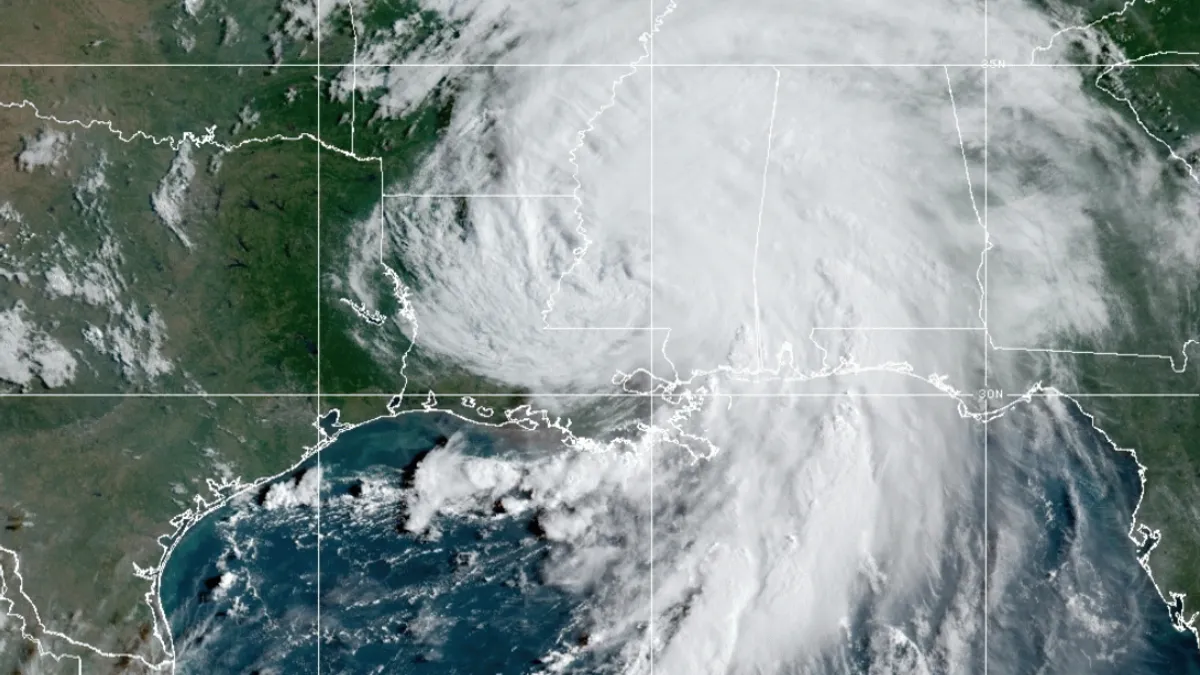Dive Brief:
- More than 1 million people were without power this morning in Louisiana and Mississippi, according to PowerOutage.us, after Hurricane Ida made landfall as a Category 4 storm with 150 mph winds near Port Fourchon, Louisiana. The storm struck Sunday evening and has since weakened to a tropical storm, according to the National Oceanic and Atmospheric Administration.
- The "catastrophic intensity" of the storm resulted in Entergy losing all eight transmission lines delivering power into New Orleans, the utility said in a statement Sunday evening. The loss of transmission led to a load imbalance which resulted in generation dropping offline.
- Entergy said it was working to assess damage and "identify a path forward to restore power." Experts say after making immediate repairs, the utility should consider undergrounding some critical lines.
Dive Insight:
It remains unclear how long it will take to restore power to New Orleans. Ida struck almost exactly 16 years after Hurricane Katrina destroyed parts of the city.
NPR reported some parts of New Orleans could be without power for six weeks.
In a statement issued Sunday night, Entergy warned "power will not be restored this evening," and said it was "currently working to assess damage and identify a path forward to restore power."
While all transmission lines feeding into New Orleans are out of service, Entergy is supplying emergency power to the Sewerage and Water Board of New Orleans.
Experts say Ida's damage shows a need for greater investment in transmission infrastructure and grid resilience.
"They will have to repair what is damaged pretty much as-is to get it back up as fast as possible, but we really ought to look at burying these kinds of critical infrastructure in any areas that have high chances of big storms like these coming through," said Joshua Rhodes, a research associate at the University of Texas at Austin. Rhodes' work focuses on smart grids and the bulk electricity system.
Entergy's outage center indicated more than 850,000 customers were offline Monday morning in its Louisiana territory. Cleco Power reported 90,000 customers were offline as of Sunday evening. Mississippi Power's outage center indicated about 10,000 customers in the dark, Monday morning.
Mississippi Power Storm Director Melvin Roland, in an update posted to the utility's twitter feed Sunday, wrote, "as early as it is safe to start working we are bringing in over 1,000 different resources" to help restore power.
The Edison Electric Institute, which represents investor-owned utilities, said in a Sunday statement that mutual assistance workers from at least 30 states and the District of Columbia "are mobilized to assist when and where they can, provided it is safe to do so."
Utilities in Ida's path had activated their emergency response plans and have strategically pre-positioned equipment, resources, and mutual assistance workers from other states to assist in their storm response as conditions allow," EEI said.
Utilities are spending increasing amounts to combat the impacts of climate change. Entergy's 2020 filings with the Climate Disclosure Project showed the utility spending $450 million annually on system hardening, including investing in transmission and elevating substations to address the risks from flooding.
Rhodes said a comprehensive study examining coastal areas prone to storms could potentially identify a few key transmission assets where spending money to put them underground could have significant reliability impacts.
"And maybe the best option is not to bury them all, but perhaps a few so that critical services can hopefully continue to operate and the local power plants can be restarted as soon as the local system is stable," Rhodes said.
Damage done by Ida to the power system "only reinforces the need for a more resilient grid," Larry Gasteiger, executive director of WIRES, said in a statement. The group advocates for proactive transmission planning.
"Extreme weather events like Ida show the value of investment in local transmission projects to replace aging transmission infrastructure with stronger more resilient build out," Gasteiger said. "The fact is we need a huge boost in transmission investment now, and we are far behind where we need to be.”














